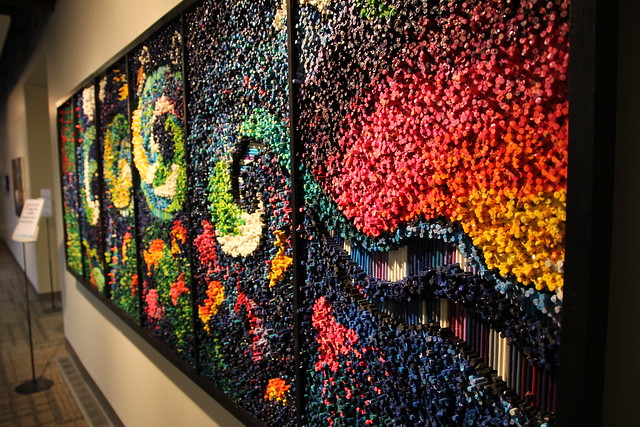Of the 174 venues hosting art in this year’s ArtPrize competition, 59 can be found in the Heartside District. To scale it down to parameters nearby Cathedral Square, here is a guide to the 14 neighborhood venue locations along the strip of South Division, beginning at our showcase venue and descending by location to the Fulton intersection:
1) This list starts with Cathedral Square. Begin your ArtPrize expedition in our venue on the second floor of Cathedral Square Center. Enjoy art selected within our 2014 theme, “HeArtbeat: The Pulse of Art & Life”, which embodies rhythm as a compositional device and subject matter, and reflects the culture of Heartside in which we are rooted. // 360 S. Division
2) The next stop on this tour lands at Avenue for the Arts (AftA). As residents in Heartside, they are active participants in shaping the neighborhood. AftA has been recognized as a center for arts and culture in Grand Rapids, with honors such as the 2004 Cool Cities Designation and 2009 Neighborhood Business Alliance Award. // 307 S. Division
3) The next stop on your ArtPrize venture is Take Hold Church. They were nominated as one of the top five venues in 2012. This year they will be featuring the artistic creations of Hannah Johnson from Ohio. // 222 S. Division
4) As you mosey north along Division, you'll discover Dégagé Ministries. Dégagé is on the corner of Division and Cherry an area which is often bustling with activity. They have large windows where artwork can be displayed outward facing south and west. There are sidewalks and easy crossing for patrons and visitors. // 144 S. Division
5) Don’t miss the exhibit at Have Company. Have Company is a general store and artist residency space specializing in local handmade goods, small publications, and collaboration. They also host a rotating domestic residency program, where artists come to live, work and teach in the space. // 136 S. Division
6) Tune into the entries at Vertigo Music. Vertigo is the largest record store in West Michigan. They say they are “not the right place for extremely religious or patriotic art.” Vertigo makes space for 2D and 3D work, displayed in large front windows facing S. Division. // 129 S. Division
7) The next stop will land you at Parliament the Boutique. Parliament is the studio home and showroom of Littlewings Designs. Parliament is proud to host Grand Rapids ceramic and installation artist Kate Lewis with ceramics that guide the viewer through an experience of peace and acceptance. // 120 S. Division
8) Visit two venues in one location: The Bandit Queen and Propaganda Doughnuts. The Bandit Queen is hosting a "junk-chic" theme of a spice-route gypsy caravan, circa the Victorian era -- borderline Steampunk (but more tasteful). Propaganda Doughnuts is a small urban doughnut shop with a pulp-fiction spy/detective/mystery theme and an art-nouveau style. They are open late with sweet and savory offerings that draw people in day and night. // 117 S. Division
9) The next duo you'll want to visit combines The Local Epicurean and Harris Building. During ArtPrize the Harris Building will be hosting pop up events and services as well as large events. There are many unique areas and situations available to showcase all types of art media. The Local Epicurean is a specialty pasta company with an indoor Italian food shop. // 111 S. Division
10) The next venue is located at the Calvin College (106) Gallery. The (106) Gallery is part of a reclaimed building housing over a dozen live/work artist units, operated by the Calvin College Department of Art and Art History. During ArtPrize, the gallery strives to curate a cohesive exhibition of artists with compelling and complementary artwork. // 106 S. Division
11) The tour continues with Heartside Gallery & Studio. Heartside Gallery & Studio displays its artists entries in its large front windows. They will be showcasing art made by local Heartside Neighbors. // 48 S. Division
12) Don’t miss the exhibit at Rockwell | Republic. Rockwell | Republic is a restaurant-lounge providing two distinct dining atmospheres and three bar areas. They strive for an ambiance that is relaxed, smart and cool. // 45 S. Division
13) The next stop on your ArtPrize tour should be Craft House. Craft House is a collaborative exhibition space and artist resource interested in hosting artists who appreciate the value of collaboration in the process of art making. They will feature the project “Love is Cliché” by Grand Rapids artist Alaina Clarke for ArtPrize 2014. // 40 S. Division
14) Finally on this South Division tour, enjoy work at the Urban Institute for Contemporary Arts (UICA). This exhibition center sits at the corner of Fulton and Division. UICA has been pushing contemporary art and the creative community to the forefront of the city for 37 years. Their 2014 exhibition theme is COLLABORATION, featuring art and artists that build upon exploration into inspired combinations. // 2 W. Fulton
For more exploration of Cathedral Square and the Heartside Neighborhood, “like” our Facebook page:
ArtPrize at Cathedral Square




















